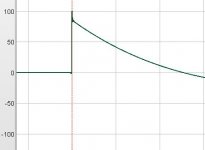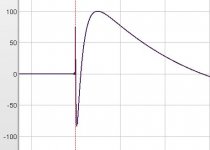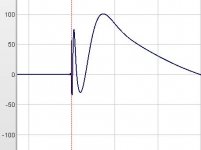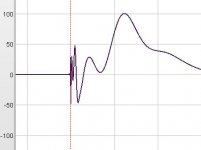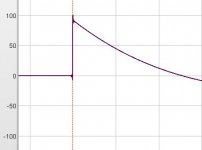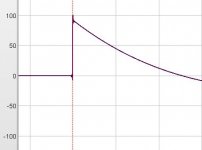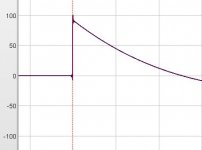I just noticed some fellow diy'ers rolling on a topic of steep vs shallow crossover advantage. Mabat, Gedlee, Mark100....whoever else...I'm looking at you. lol!

I want to do the thing where you guys say things and I learn from it. If I were to guess... the steep crossover introduces so much group delay that it is potentially detrimental to the SQ, and the increased sharing of the signal between the two drivers can be much less on an issue, once again, potentially.
Well, the steeper the crossover slope(s), the more precisely must the individual radiation patterns below and above the crossover point match - this is what you should be looking for then. Frankly, I'm not a fan of very high slopes, 24 dB/octave is about my reasonable limit. I know that nowadays with DSP it is no problem to make it steeper but I don't really see the point - I don't see a broader overlap necessarily as a bad thing.
I agree, I think very steep crossovers are a bad idea. My system was 3rd order LP and first order HP, although that is misleading since the waveguide response is not flat so there is also a first order HP at 10 kHz as well.
I had designs for s system that could go down lower, probably 500 Hz, but the costs just got in the way. It needs to be much larger with an 18" woofer and would have raised the price by probably 50% over the NS15. Not worth it IMO.
In fact, when I look back on "value" (performance / cost) the 12" was the sweat spot. But the 15" was a little better, just cost a lot more.
I've been having what I believe are very good results using steep xovers.
Don't have much theory or simulation experience to back this up, I just take a lot of measurements.
I always use linear phase xovers, Linkwitz-Riley or any other fully complementary xover, and then vary the xover freq and order as I make polar measurements looking for even patterning.
So far, on typical off the shelf horns for 1.4" CDs and a few synergy attempts, steep has given better vertical polars.
Steep has also allowed me a bit more latitude in choosing xover freq, not having to worry about lower excursion issues, and being able to focus more on pattern exchange.
All this has been with a fairly narrow build formula however, CD to 12" or 12"s in the 500Hz to 700Hz range
(I use 12" because I need big subbage and 15"s are too little to works as subs, and for other supposed theoretical advantages, like staying pistonic etc.)
Hi Gedlee... all the studio monitors seem to favor steep crossovers, not saying much, but, I thought the idea the less interaction between the speakers the less issues caused by the interaction at crossover. Though steeper crossovers have a downside I thought it was a trade for the greater good? With a shallow slope, much more sharing of the bandwidth, how does one deal with the issues this causes?

I want to do the thing where you guys say things and I learn from it. If I were to guess... the steep crossover introduces so much group delay that it is potentially detrimental to the SQ, and the increased sharing of the signal between the two drivers can be much less on an issue, once again, potentially.
Last edited:
It all depends on the drivers and the design goals.
If you were doing 8+1 design with a acoustic LR2 target at 2Khz, your off-axis performance would be quite poor (directivity-wise). You'd need to drop back to 1.5KHz, or use steeper slopes. I'd be using LR6 for such a design.
If you had a 5+1 design, I don't see why you would want more than LR12 - unless it was a metal cone with breakup peaks. Then you'd need LR24 with a resonance trap (which actually does also mess up off-axis a bit, a couple of octaves above XO.
3-ways avoid a lot of this but have interaction between the top and the bottom driver in the middle of the midrange's passband, so you have to be very careful with overall system phase because of the massive distance between those drivers. LR12 may not be always possible.
Both are valid approaches.
If you were doing 8+1 design with a acoustic LR2 target at 2Khz, your off-axis performance would be quite poor (directivity-wise). You'd need to drop back to 1.5KHz, or use steeper slopes. I'd be using LR6 for such a design.
If you had a 5+1 design, I don't see why you would want more than LR12 - unless it was a metal cone with breakup peaks. Then you'd need LR24 with a resonance trap (which actually does also mess up off-axis a bit, a couple of octaves above XO.
3-ways avoid a lot of this but have interaction between the top and the bottom driver in the middle of the midrange's passband, so you have to be very careful with overall system phase because of the massive distance between those drivers. LR12 may not be always possible.
Both are valid approaches.
Interesting, Two matching woofers is one thing, but two different drivers with different mass and compliance...covering the same frequency, sounds like an issue but I've never been able to hold a conversation with you guys about it, I don't think.
I've read that 2.5ways with different woofers can work...but no detail into how to make it work or how to approach making it work. Makes me wonder what happens in a 2way MTM using different woofers. All relating to drivers sharing spectrum.
I've read that 2.5ways with different woofers can work...but no detail into how to make it work or how to approach making it work. Makes me wonder what happens in a 2way MTM using different woofers. All relating to drivers sharing spectrum.
It has always been an issue and will continue to be an issue. This is why speakers sound different from each other, quite apart from objective measurements. It is difficult to quantify those differences and given the path audio is taking over the last decade or so, I doubt much will ever be looked into wrt multi-way speakers, except in communities like this one.
I don't know who else you're trying to converse with, but my approach has to always try to make things as harmonious as possible between drivers, and trying to get drivers out of the way as gracefully and quickly as possible (the two contradict each other).
I don't know who else you're trying to converse with, but my approach has to always try to make things as harmonious as possible between drivers, and trying to get drivers out of the way as gracefully and quickly as possible (the two contradict each other).
I am no expert, but i use as steep croosover for sub, and first order shalow for satelites. Sounds good to me.
Something like S. Harsch crossover, steep on lower pass, shalow on upper. Goal is linear phase.
Just to make things little bit more complicated for you.
Something like S. Harsch crossover, steep on lower pass, shalow on upper. Goal is linear phase.
Just to make things little bit more complicated for you.
It has always been an issue and will continue to be an issue. This is why speakers sound different from each other, quite apart from objective measurements. It is difficult to quantify those differences and given the path audio is taking over the last decade or so, I doubt much will ever be looked into wrt multi-way speakers, except in communities like this one.
I don't know who else you're trying to converse with, but my approach has to always try to make things as harmonious as possible between drivers, and trying to get drivers out of the way as gracefully and quickly as possible (the two contradict each other).
I'm working on crossing a 18" and a 15" start at 200hz and down....I wan't to minimize beaming to shorten listening distance, that would ask for a steep filter would it not?
An 18" at 200 can be crossed LR4, a 15" at the same frequency I think up to BW 3rd order might be acceptable. 12" you can get away with LR2, just about.
When you say "steep" what are you thinking? 6/8/10th order? Personally I wouldn't want to go more than 4th order, except when absolutely necessary. I think a LR6 target is the maximum I can mentally conceive of.
From what I've learnt (mostly from here) is that you need to look at the phase when the driver is 40dB down. You should be less than 90 degrees out of phase wrt the summed phase, the lower the better. This makes steep slopes sometimes unattainable regardless of the fr target.
When you say "steep" what are you thinking? 6/8/10th order? Personally I wouldn't want to go more than 4th order, except when absolutely necessary. I think a LR6 target is the maximum I can mentally conceive of.
From what I've learnt (mostly from here) is that you need to look at the phase when the driver is 40dB down. You should be less than 90 degrees out of phase wrt the summed phase, the lower the better. This makes steep slopes sometimes unattainable regardless of the fr target.
One thing I suggest is grab XSim and try some of your questions out. 🙂
The ideal / default speaker drivers are great for trying out different filters and seeing how the group/phase plots add up.
Best,
E
The ideal / default speaker drivers are great for trying out different filters and seeing how the group/phase plots add up.
Best,
E
From about 200hz and down to 30hz I have to share a 15 and 18...the 15 crossing to the 18...
To me steep is a 48db LR.
I’m wondering how to marry the two drivers below 200hz
To me steep is a 48db LR.
I’m wondering how to marry the two drivers below 200hz
If you have access to software or hardware that can produce linear phase crossovers and are making the system active, a simple way to cross any driver to another is to measure the driver in the box equalize it to be flat for an octave or two either side of the crossover point, time align the drivers with delay and use whatever form of linear phase crossover you want between them. That will give you very good summation. The slope and type of crossover will have the same effects as in any other version but with the drivers being flat either side, the time being aligned and the crossover having no phase turn will make the summation good.
The issue of linear phase filters, preringing etc. and whether that is better than another approach is a whole different subject though.
If you are stuck with a passive crossover none of that will work, if you are stuk with IIR active then steep slopes will introduce a lot of phase turn which will have other negative effects.
So decide what equipment you have or are willing to get first as that will dictate what crossover scheme you can try.
The issue of linear phase filters, preringing etc. and whether that is better than another approach is a whole different subject though.
If you are stuck with a passive crossover none of that will work, if you are stuk with IIR active then steep slopes will introduce a lot of phase turn which will have other negative effects.
So decide what equipment you have or are willing to get first as that will dictate what crossover scheme you can try.
What i find interesting is how much i enjoy the sound of Gauder Akustik, various models. They all have 50db/oct passive crossovers which is probably the only way to make Accutons listenable. It is hard to make sweeping generalisations about the effect of steep crossovers.
... the steep crossover introduces so much group delay that it is potentially detrimental to the SQ...
There is a clear split between minimum phase crossovers and DSP crossovers that can do linear phase and similar tricks.
Important to consider answers with this in mind, implies 3 types-
1 Applicable to all crossovers, unavoidable.
2 Applicable to minimum phase (analog and most acoustic effect) crossovers.
3 Applicable to DSP crossovers.
For instance steep crossovers don't have to have delay problems in DSP.
(at least, not if the extra, fixed delay of the DSP is OK, as it usually is)
Best wishes
David
Last edited:
Hi camplo, let me first say i'm very much in agreement with fluid's post.
I think it's completely understandable there is a general aversion to steep crossovers, for good reasons.
Historically, we've had IIR passive, then IIR active, then IIR dsp, and now dsp that does IIR and FIR.
Point is, most of the general knowledge is deeply rooted in IIR, and steep IIR has proven to have issues.
As we well know, IIR induces 90 degrees of phase rotation per order, for each xover in the speaker.
Increasing group delay, and time smear, with each order, and with each additional xover.
There's always debate about the audibility of group delay and phase rotation, but i think nearly everyone will admit there is a general consensus that traditional IIR xovers sound better, the lower the order that can be successfully used.
I saw you plodding thru some step plots on your main thread...
I'm not a fan of using step or impulse plots for speaker tuning because they are too hard to draw conclusions from that can be acted on.
But they do give a good picture of our speakers in the time domain.
Anyway, to show the time smear inherent in increasing orders of IIR xovers, below are some step plots of a 3-way's electrical xovers summed back together.
Magnitude response is perfectly flat for all; it's the increasing phase rotation that makes the change in the step responses.
In order BW6, LR12, LR24, and LR 48.
It's interesting to note, that these step responses are as good as it can get using IIR for a 3-way using said xovers.
IOW, no matter how well behaved the drivers are, and how well chosen xover points are....this is the best theoretical response possible, even perfectly on axis.
(a response which isn't possible due to additional natural driver rolloff, even onax)
They make a good case against steep IIR crossovers imo ...
Next post, i'll try to make a case for steep xovers...😀
(you caught me just right for this..shoulder surgery last week and can't do much else for a while, even though i'm doing quite well 🙂)
I think it's completely understandable there is a general aversion to steep crossovers, for good reasons.
Historically, we've had IIR passive, then IIR active, then IIR dsp, and now dsp that does IIR and FIR.
Point is, most of the general knowledge is deeply rooted in IIR, and steep IIR has proven to have issues.
As we well know, IIR induces 90 degrees of phase rotation per order, for each xover in the speaker.
Increasing group delay, and time smear, with each order, and with each additional xover.
There's always debate about the audibility of group delay and phase rotation, but i think nearly everyone will admit there is a general consensus that traditional IIR xovers sound better, the lower the order that can be successfully used.
I saw you plodding thru some step plots on your main thread...
I'm not a fan of using step or impulse plots for speaker tuning because they are too hard to draw conclusions from that can be acted on.
But they do give a good picture of our speakers in the time domain.
Anyway, to show the time smear inherent in increasing orders of IIR xovers, below are some step plots of a 3-way's electrical xovers summed back together.
Magnitude response is perfectly flat for all; it's the increasing phase rotation that makes the change in the step responses.
In order BW6, LR12, LR24, and LR 48.
It's interesting to note, that these step responses are as good as it can get using IIR for a 3-way using said xovers.
IOW, no matter how well behaved the drivers are, and how well chosen xover points are....this is the best theoretical response possible, even perfectly on axis.
(a response which isn't possible due to additional natural driver rolloff, even onax)
They make a good case against steep IIR crossovers imo ...
Next post, i'll try to make a case for steep xovers...😀
(you caught me just right for this..shoulder surgery last week and can't do much else for a while, even though i'm doing quite well 🙂)
Attachments
In the pics I'm pretty sure we are looking at (from left to right) Declining high frequency response and added group delay in the lower...its obviously a low pass filter.
So the shape of the impulse depends on if its a high or low pass xover and placement within the register.
So the shape of the impulse depends on if its a high or low pass xover and placement within the register.
In the pics I'm pretty sure we are looking at (from left to right) Declining high frequency response and added group delay in the lower...its obviously a low pass filter.
So the shape of the impulse depends on if its a high or low pass xover and placement within the register.
Hi camplo, not correct at all. Sorry i wasn't clearer about what they are.
They are a 3-way's three electrical passbands summed back together, to give a full range response. So two xovers in play, where the xovers are both as listed.
Every one of those step plots was derived from an essentially perfectly flat full-range magnitude trace associated with each of them.
So, they have identical magnitude responses!
The difference in them is solely due to the amounts of phase rotation from the increasing xover orders used!
(just about to send why/how steep works for me 🙂
Ok, enough of IIR where steep doesn't work....
on to FIR, used linear phase, where steep works...
Below is a set of 3-way linear phase xovers, using the same xover frequencies as my previous post, and with increasing orders as before.
LR12, LR48, and even a really steep LR96.
Haha...all the same, huh?😀
And it can be mix and match...LR96 on first xover and LR12 on second...doesn't matter...all will stay the same..
Here's the advantages i've found using linear phase steep slopes...(i should add fully complementary)
- steep slopes allow the use of less behaved drivers, the drivers don't have to roll off as smoothly, farther out of band
-it allows easier multi-way design where passbands are trickier to integrate (i'm in to 4-ways), .....and still without any group delay buildup
-those two advantages definitely accommodate higher SPL and deeper LF extension designs with multi-ways, ime
-it better protects against drivers' over-excursion at the bottom of their passbands (if the desire for higher SPL and LF extension have made that an issue for any of the drivers)
-this point isn't about steep, but flat phase in general.....
It is soooooooo much easier to stitch together flat phase traces than steep ones. (Part of the reason an IIR 2-way BW6 works so well)
So with linear phase, you get the ease of flat phase traces to work with, no matter the rolloff orders.
If you do as fluid suggested and apply out of band flattening to the drivers as well, then tying passbands' phase traces together becomes nearly trivial.
The odds for achieving a well tuned speaker go up dramatically ime.
Ok, so far the points have probably been as much about linear phase in geral, as about steep vs flat.
Where I think steep really helps is with off-axis uniformity.
Particularly vertical, but horizontal too.
-When the frequency range of two drivers producing the same sound overlaps, i keep measuring that minimizing the width of the overlap range helps reduce changing response in the overlap....i mean, pretty simple really..
-another nice thing about steep and linear, is that it allows for relatively easy movement of the xover freq up and down in search of best pattern matching.
All that matters is whether the passband mag and phase performance have stayed flat at the new xover points...which is usually the case when out of band flattening was applied.
Anyway, i think IIR steep is to be avoided.
FIR linear phase steep, to be lovingly embraced 😉
just my 2 cents 🙂
on to FIR, used linear phase, where steep works...
Below is a set of 3-way linear phase xovers, using the same xover frequencies as my previous post, and with increasing orders as before.
LR12, LR48, and even a really steep LR96.
Haha...all the same, huh?😀
And it can be mix and match...LR96 on first xover and LR12 on second...doesn't matter...all will stay the same..
Here's the advantages i've found using linear phase steep slopes...(i should add fully complementary)
- steep slopes allow the use of less behaved drivers, the drivers don't have to roll off as smoothly, farther out of band
-it allows easier multi-way design where passbands are trickier to integrate (i'm in to 4-ways), .....and still without any group delay buildup
-those two advantages definitely accommodate higher SPL and deeper LF extension designs with multi-ways, ime
-it better protects against drivers' over-excursion at the bottom of their passbands (if the desire for higher SPL and LF extension have made that an issue for any of the drivers)
-this point isn't about steep, but flat phase in general.....
It is soooooooo much easier to stitch together flat phase traces than steep ones. (Part of the reason an IIR 2-way BW6 works so well)
So with linear phase, you get the ease of flat phase traces to work with, no matter the rolloff orders.
If you do as fluid suggested and apply out of band flattening to the drivers as well, then tying passbands' phase traces together becomes nearly trivial.
The odds for achieving a well tuned speaker go up dramatically ime.
Ok, so far the points have probably been as much about linear phase in geral, as about steep vs flat.
Where I think steep really helps is with off-axis uniformity.
Particularly vertical, but horizontal too.
-When the frequency range of two drivers producing the same sound overlaps, i keep measuring that minimizing the width of the overlap range helps reduce changing response in the overlap....i mean, pretty simple really..
-another nice thing about steep and linear, is that it allows for relatively easy movement of the xover freq up and down in search of best pattern matching.
All that matters is whether the passband mag and phase performance have stayed flat at the new xover points...which is usually the case when out of band flattening was applied.
Anyway, i think IIR steep is to be avoided.
FIR linear phase steep, to be lovingly embraced 😉
just my 2 cents 🙂
Haha...im an idiot...dont know where the linear phase step plots went...they were in preview up until posting..😕
Glad i just looked at this thread again...sorry
Anyway, in order LR12, LR48, and LR 96
still all the same 😀
Glad i just looked at this thread again...sorry
Anyway, in order LR12, LR48, and LR 96
still all the same 😀
Attachments
What devices could be used as linear phase crossovers? On a budget...and how does one define them? Either standalone or on a PC with Linux?
These do not show the efficacy of a steep crossover, they are just filters used along the way.still all the same 😀
What devices could be used as linear phase crossovers? On a budget...and how does one define them? Either standalone or on a PC with Linux?
I guess a decent way of defining the devices, is either PC, or hardware processor. Like you said really, PC or standalone.
For the PC route, I had good success with JRiver and Convolver Convolver ? a convolution plug-in and the Convolver Config File Config file
Been a while, don't remember exactly how it all went together, other than it was easier than it first looked.
I used a miniDSP openDRC DA-8 as standalone for a while. It's a pretty nice 2x8 solution, and has enough taps and the flexibility to do a decent job. Some people fault the DAC quality a little, but who knows.
As far as FIR file creation, I highly recommend getting started with rephase.
I think until we get a little FIR/crossover/unlimited EQ , minimum phase vs linear phase familiarity under our belt, more automated programs likely lead to counterproductive over tuning.
Oh, and avoid the temptation to use a boat load of taps....for anything other than the maybe sub range.
My guess is making that mistake, like 16k to 65k taps, is probably what has led to pre-ringing, or maybe better said, pre-echo, reports.
Those are just a few things that have worked for me...and at not much $😀
- Home
- Loudspeakers
- Multi-Way
- Steep Crossovers...3 steps forward, 2 steps back?
